Chief Resident Resume Examples
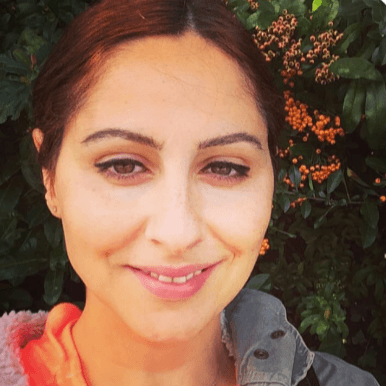
Jul 18, 2024
|
12 min read
"Crafting your chief resident resume: standing out in the role of chief problem solver – learn the best tips and tricks to showcase your leadership and medical skills effectively."
Rated by 348 people
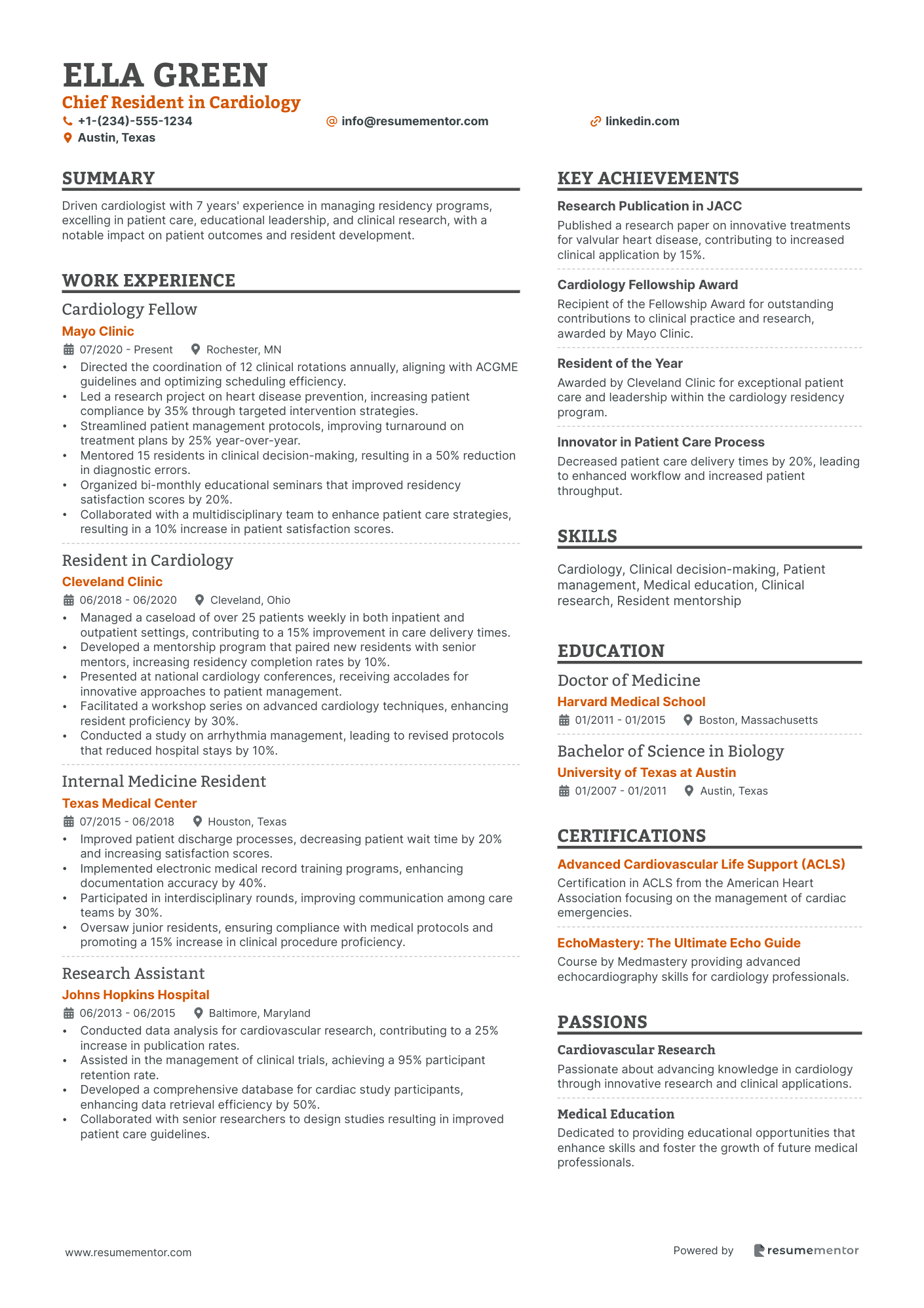
Chief Resident in Cardiology
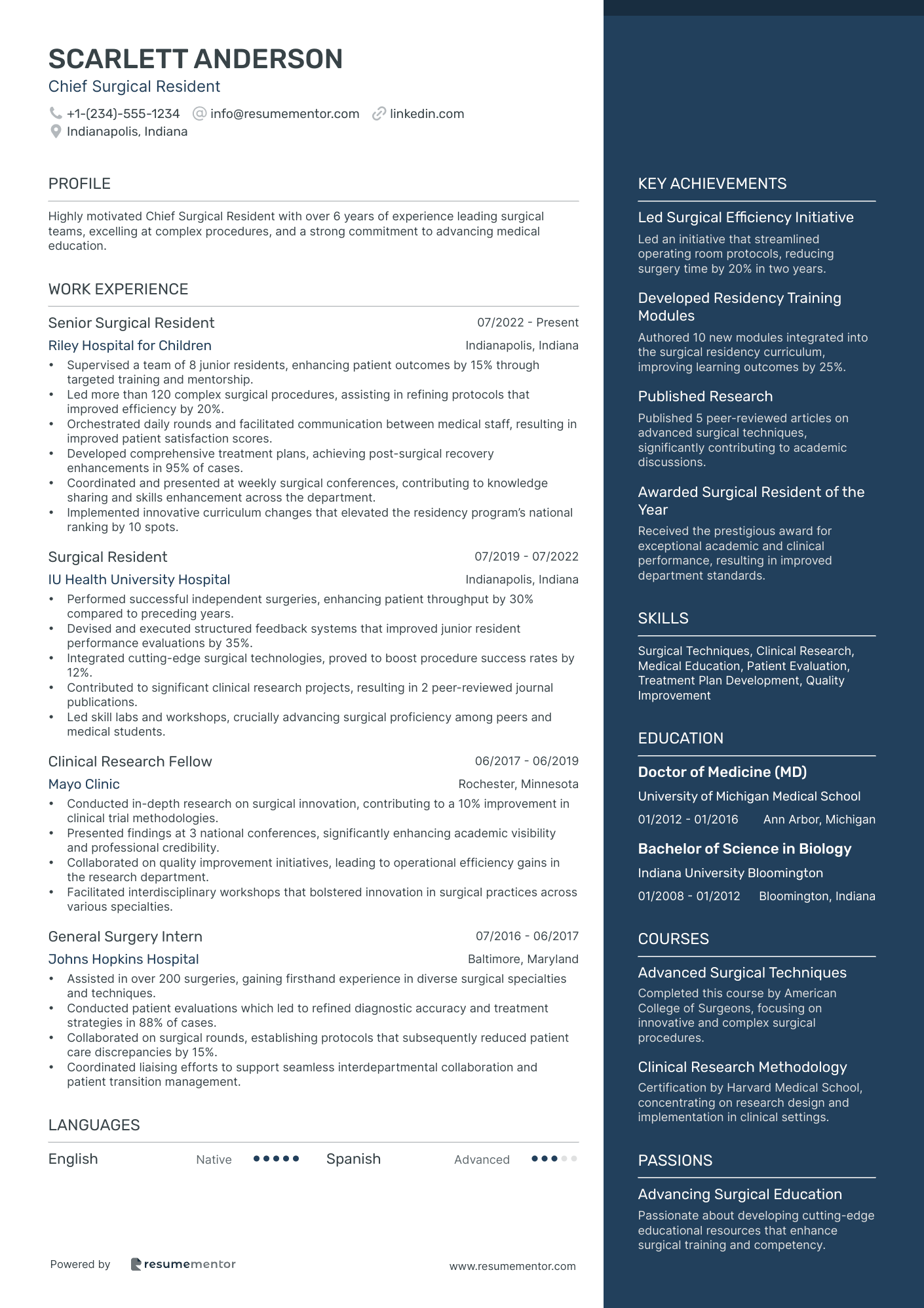
Chief Surgical Resident
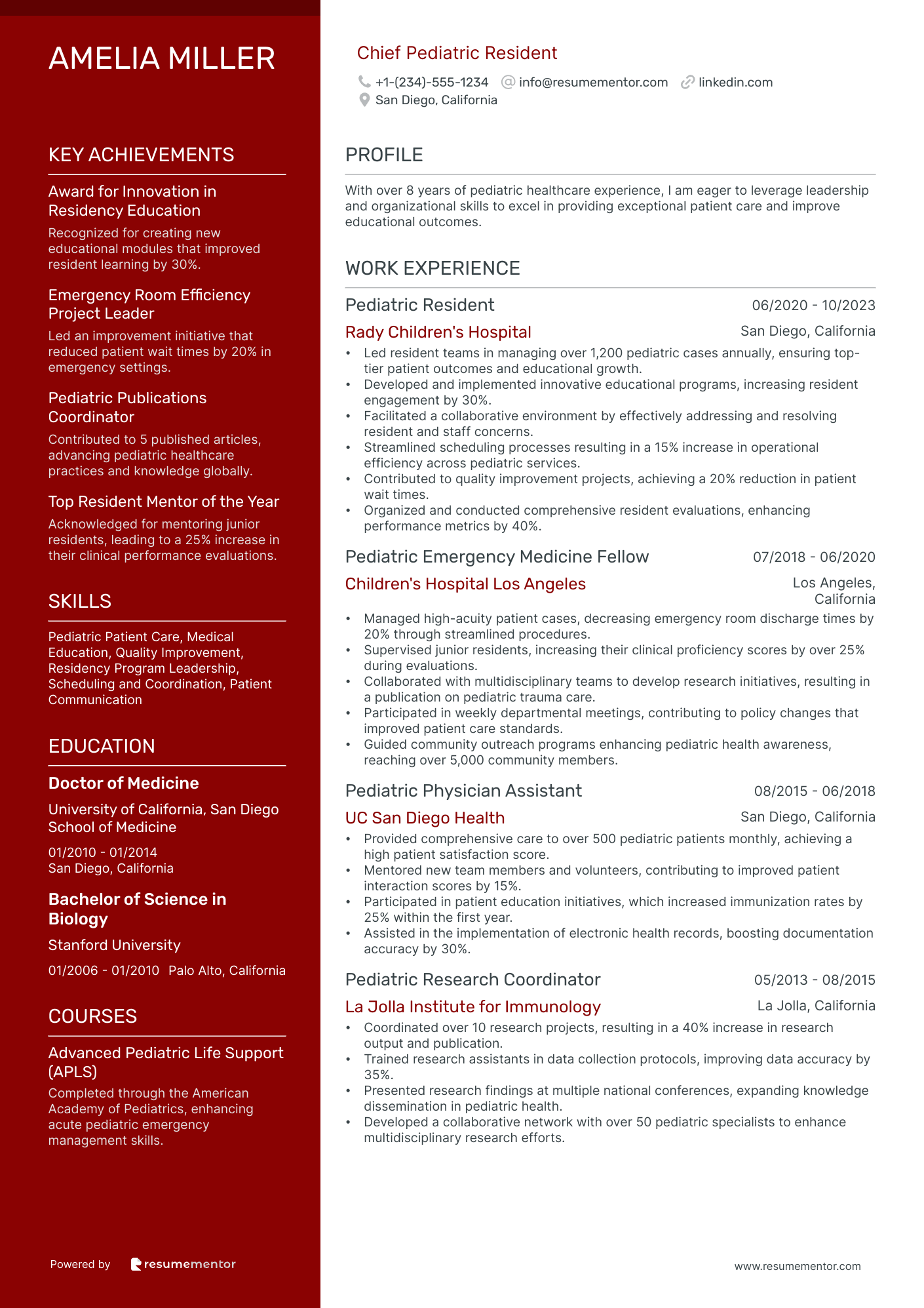
Chief Pediatric Resident
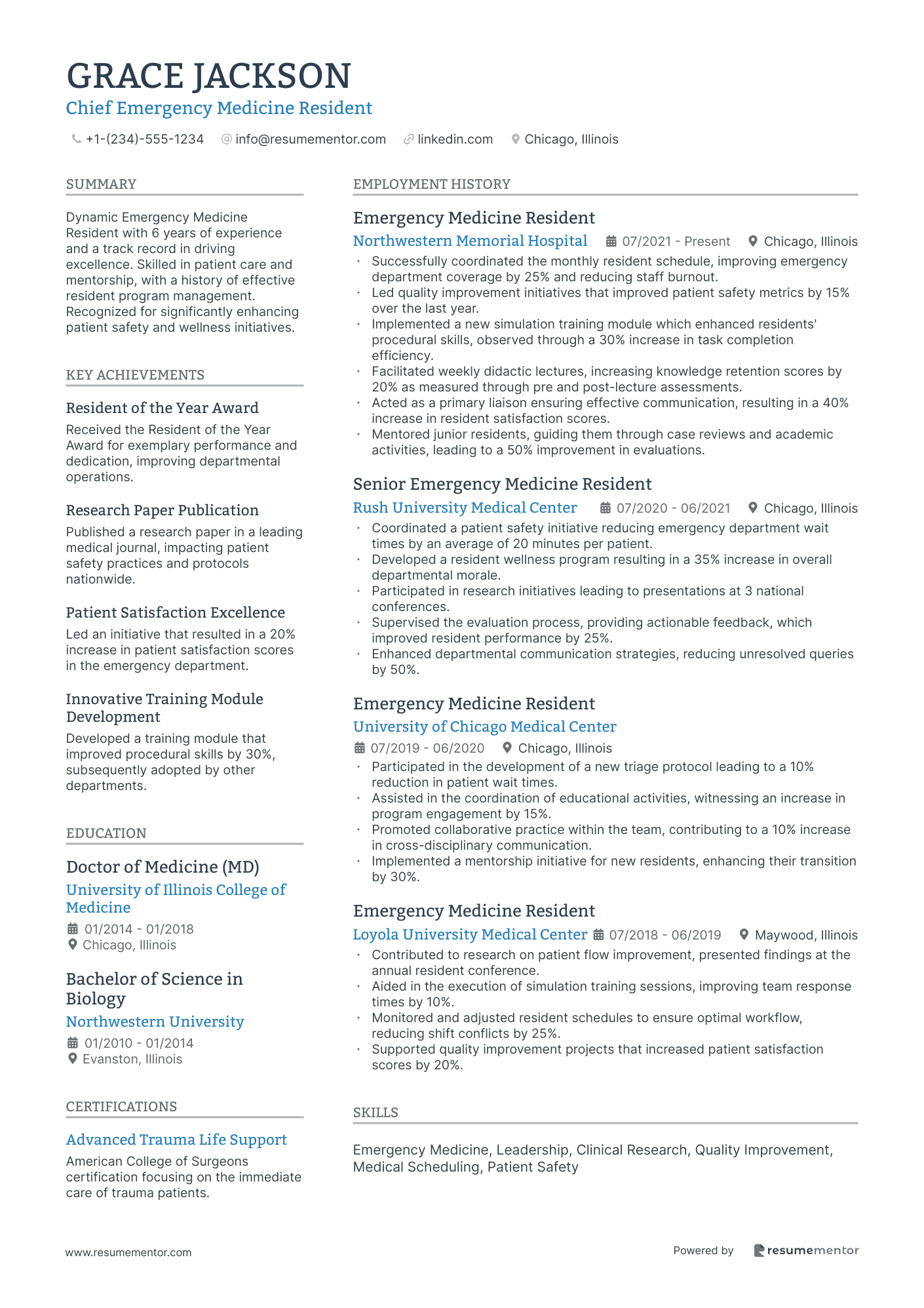
Chief Emergency Medicine Resident
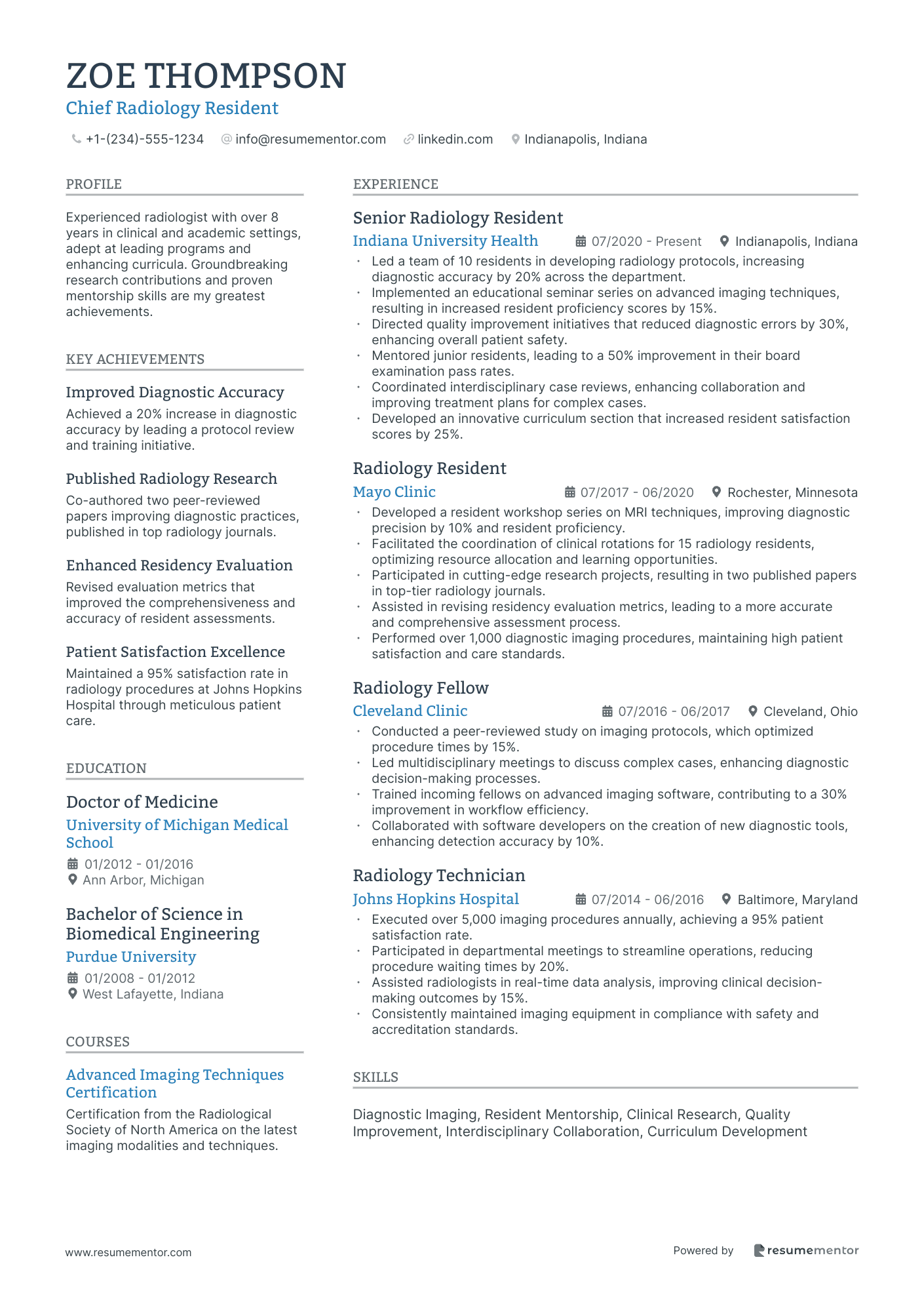
Chief Radiology Resident
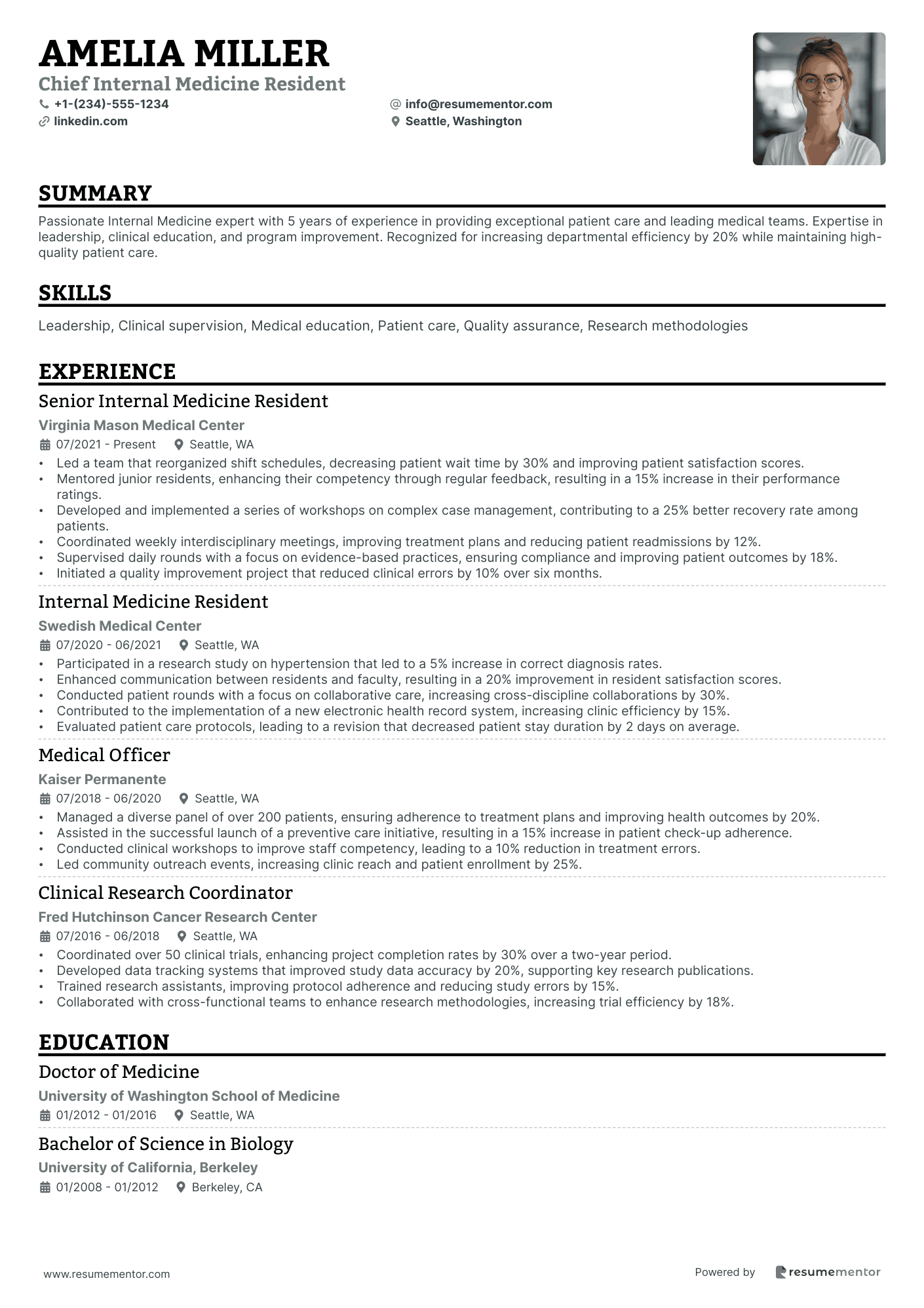
Chief Internal Medicine Resident
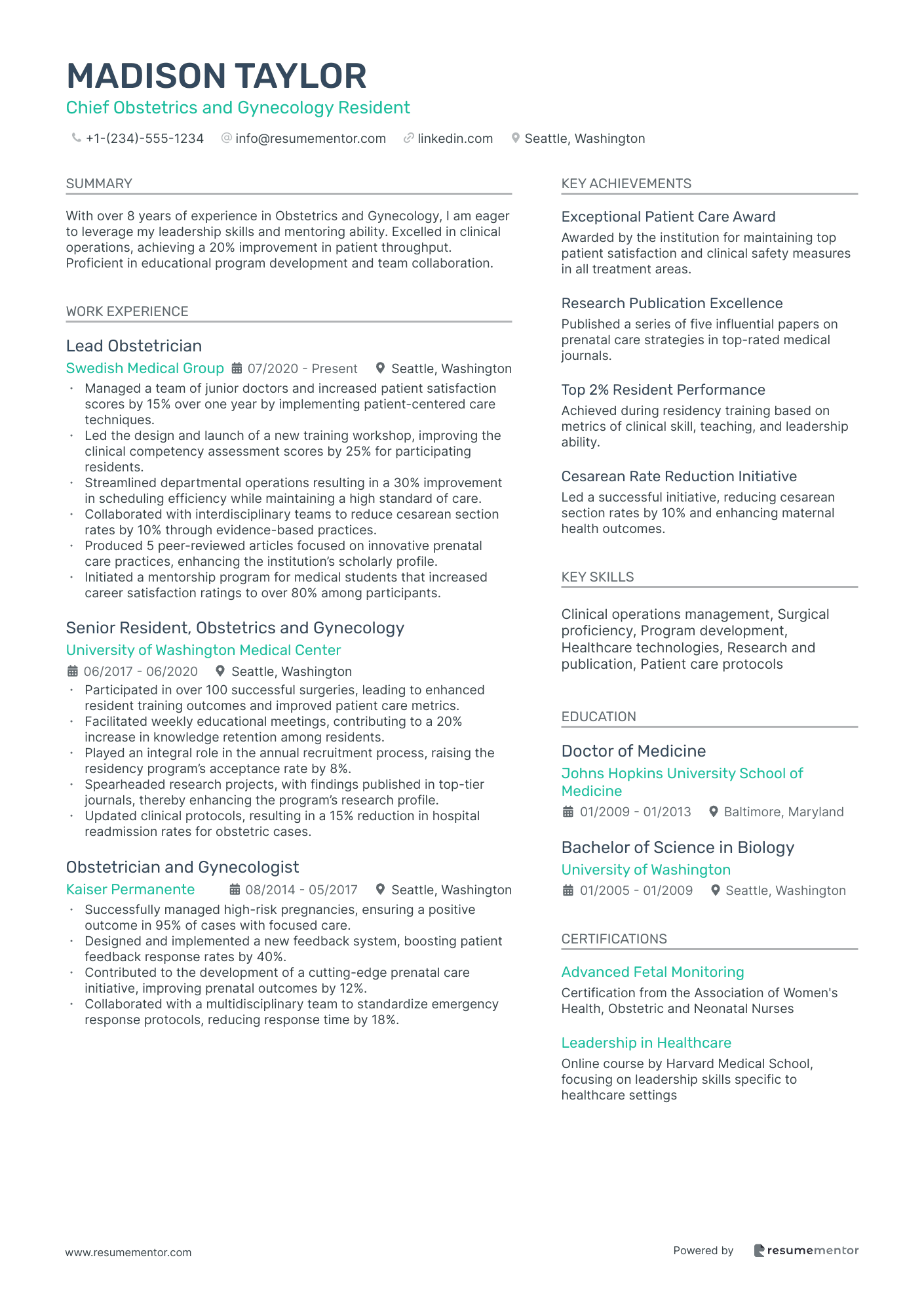
Chief Obstetrics and Gynecology Resident
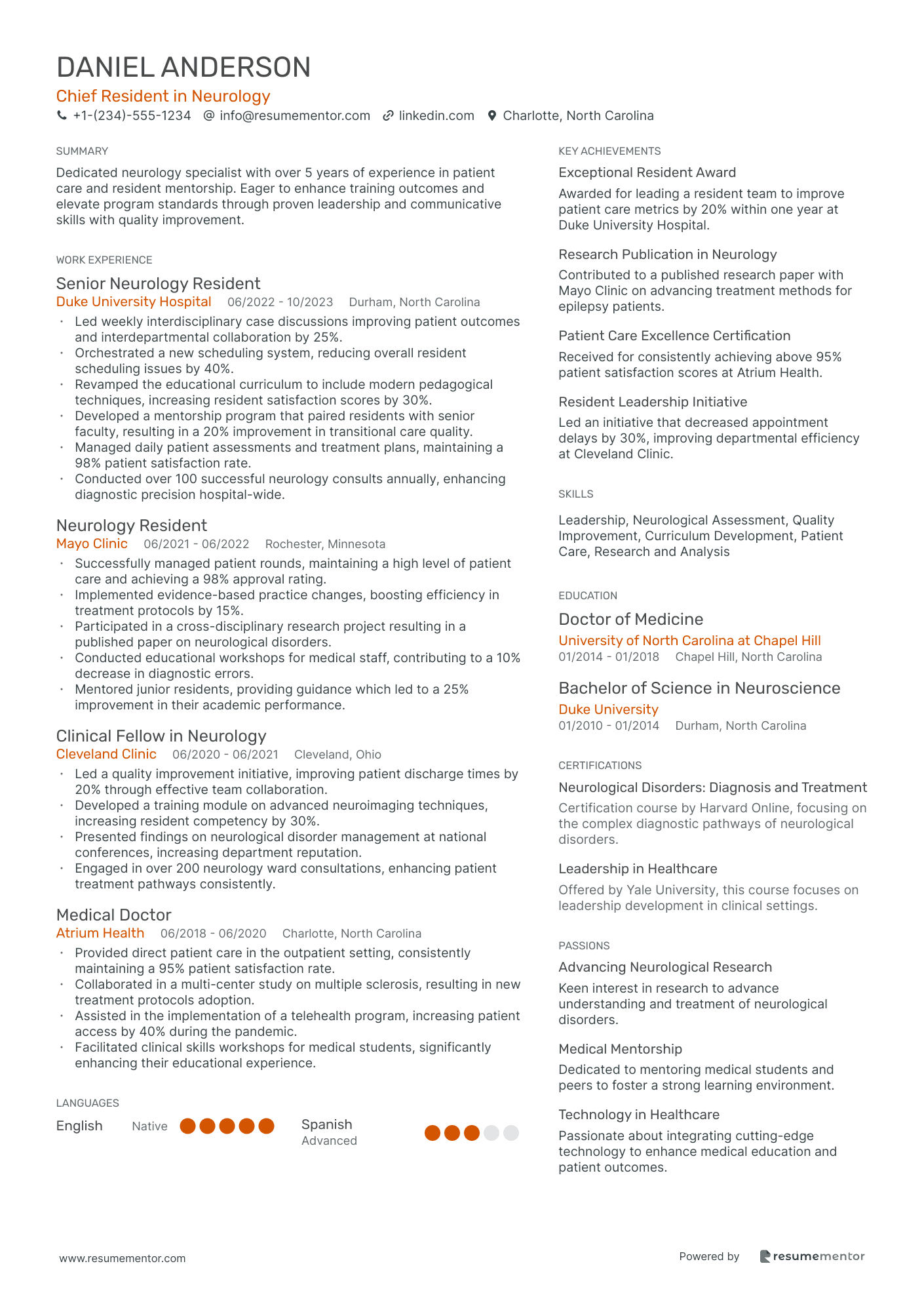
Chief Resident in Neurology
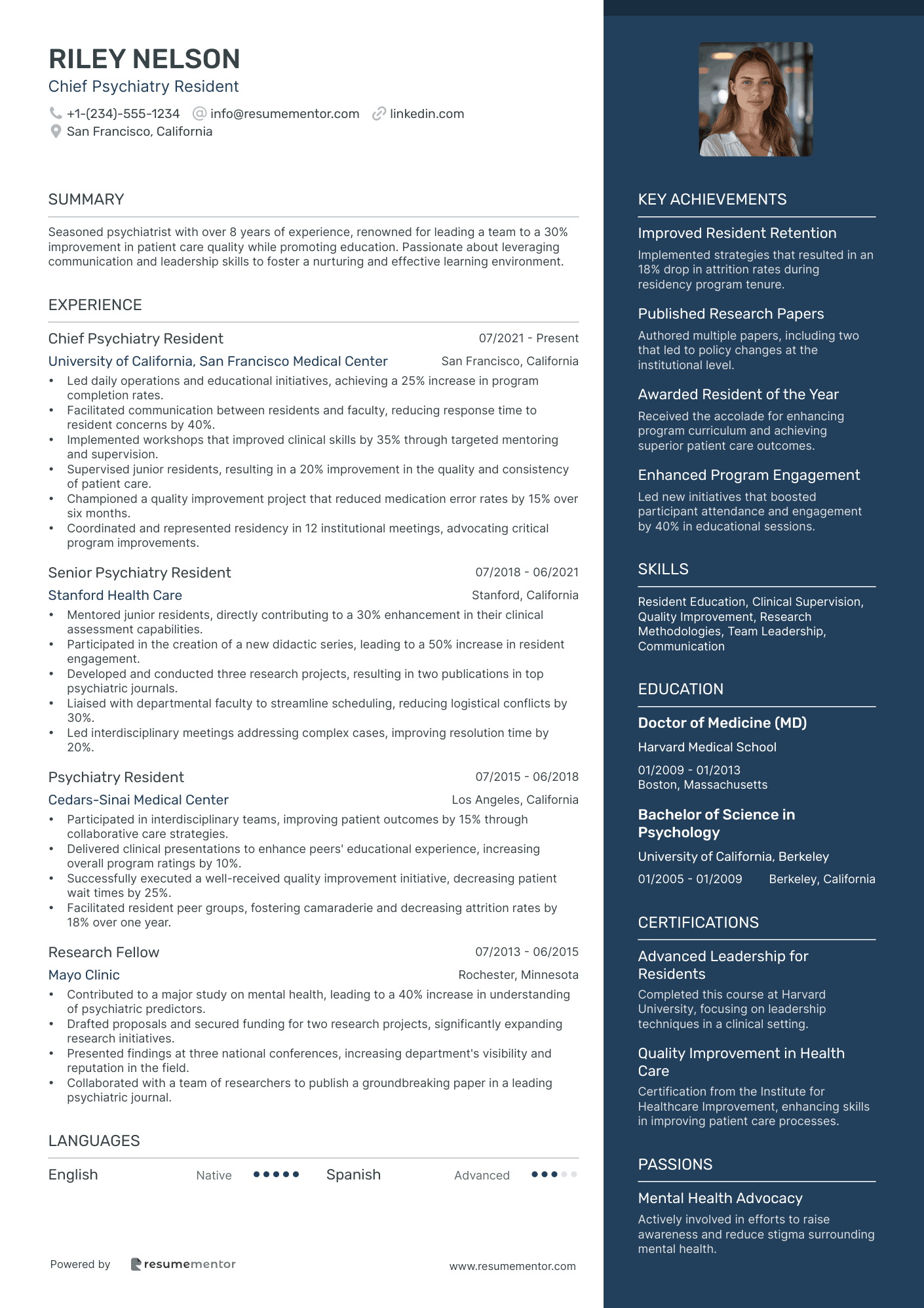
Chief Psychiatry Resident

Chief Resident in Orthopedic Surgery

Chief Resident in Cardiology resume sample
- •Directed the coordination of 12 clinical rotations annually, aligning with ACGME guidelines and optimizing scheduling efficiency.
- •Led a research project on heart disease prevention, increasing patient compliance by 35% through targeted intervention strategies.
- •Streamlined patient management protocols, improving turnaround on treatment plans by 25% year-over-year.
- •Mentored 15 residents in clinical decision-making, resulting in a 50% reduction in diagnostic errors.
- •Organized bi-monthly educational seminars that improved residency satisfaction scores by 20%.
- •Collaborated with a multidisciplinary team to enhance patient care strategies, resulting in a 10% increase in patient satisfaction scores.
- •Managed a caseload of over 25 patients weekly in both inpatient and outpatient settings, contributing to a 15% improvement in care delivery times.
- •Developed a mentorship program that paired new residents with senior mentors, increasing residency completion rates by 10%.
- •Presented at national cardiology conferences, receiving accolades for innovative approaches to patient management.
- •Facilitated a workshop series on advanced cardiology techniques, enhancing resident proficiency by 30%.
- •Conducted a study on arrhythmia management, leading to revised protocols that reduced hospital stays by 10%.
- •Improved patient discharge processes, decreasing patient wait time by 20% and increasing satisfaction scores.
- •Implemented electronic medical record training programs, enhancing documentation accuracy by 40%.
- •Participated in interdisciplinary rounds, improving communication among care teams by 30%.
- •Oversaw junior residents, ensuring compliance with medical protocols and promoting a 15% increase in clinical procedure proficiency.
- •Conducted data analysis for cardiovascular research, contributing to a 25% increase in publication rates.
- •Assisted in the management of clinical trials, achieving a 95% participant retention rate.
- •Developed a comprehensive database for cardiac study participants, enhancing data retrieval efficiency by 50%.
- •Collaborated with senior researchers to design studies resulting in improved patient care guidelines.
Chief Surgical Resident resume sample
- •Supervised a team of 8 junior residents, enhancing patient outcomes by 15% through targeted training and mentorship.
- •Led more than 120 complex surgical procedures, assisting in refining protocols that improved efficiency by 20%.
- •Orchestrated daily rounds and facilitated communication between medical staff, resulting in improved patient satisfaction scores.
- •Developed comprehensive treatment plans, achieving post-surgical recovery enhancements in 95% of cases.
- •Coordinated and presented at weekly surgical conferences, contributing to knowledge sharing and skills enhancement across the department.
- •Implemented innovative curriculum changes that elevated the residency program’s national ranking by 10 spots.
- •Performed successful independent surgeries, enhancing patient throughput by 30% compared to preceding years.
- •Devised and executed structured feedback systems that improved junior resident performance evaluations by 35%.
- •Integrated cutting-edge surgical technologies, proved to boost procedure success rates by 12%.
- •Contributed to significant clinical research projects, resulting in 2 peer-reviewed journal publications.
- •Led skill labs and workshops, crucially advancing surgical proficiency among peers and medical students.
- •Conducted in-depth research on surgical innovation, contributing to a 10% improvement in clinical trial methodologies.
- •Presented findings at 3 national conferences, significantly enhancing academic visibility and professional credibility.
- •Collaborated on quality improvement initiatives, leading to operational efficiency gains in the research department.
- •Facilitated interdisciplinary workshops that bolstered innovation in surgical practices across various specialties.
- •Assisted in over 200 surgeries, gaining firsthand experience in diverse surgical specialties and techniques.
- •Conducted patient evaluations which led to refined diagnostic accuracy and treatment strategies in 88% of cases.
- •Collaborated on surgical rounds, establishing protocols that subsequently reduced patient care discrepancies by 15%.
- •Coordinated liaising efforts to support seamless interdepartmental collaboration and patient transition management.
Chief Pediatric Resident resume sample
- •Led resident teams in managing over 1,200 pediatric cases annually, ensuring top-tier patient outcomes and educational growth.
- •Developed and implemented innovative educational programs, increasing resident engagement by 30%.
- •Facilitated a collaborative environment by effectively addressing and resolving resident and staff concerns.
- •Streamlined scheduling processes resulting in a 15% increase in operational efficiency across pediatric services.
- •Contributed to quality improvement projects, achieving a 20% reduction in patient wait times.
- •Organized and conducted comprehensive resident evaluations, enhancing performance metrics by 40%.
- •Managed high-acuity patient cases, decreasing emergency room discharge times by 20% through streamlined procedures.
- •Supervised junior residents, increasing their clinical proficiency scores by over 25% during evaluations.
- •Collaborated with multidisciplinary teams to develop research initiatives, resulting in a publication on pediatric trauma care.
- •Participated in weekly departmental meetings, contributing to policy changes that improved patient care standards.
- •Guided community outreach programs enhancing pediatric health awareness, reaching over 5,000 community members.
- •Provided comprehensive care to over 500 pediatric patients monthly, achieving a high patient satisfaction score.
- •Mentored new team members and volunteers, contributing to improved patient interaction scores by 15%.
- •Participated in patient education initiatives, which increased immunization rates by 25% within the first year.
- •Assisted in the implementation of electronic health records, boosting documentation accuracy by 30%.
- •Coordinated over 10 research projects, resulting in a 40% increase in research output and publication.
- •Trained research assistants in data collection protocols, improving data accuracy by 35%.
- •Presented research findings at multiple national conferences, expanding knowledge dissemination in pediatric health.
- •Developed a collaborative network with over 50 pediatric specialists to enhance multidisciplinary research efforts.
Chief Emergency Medicine Resident resume sample
- •Successfully coordinated the monthly resident schedule, improving emergency department coverage by 25% and reducing staff burnout.
- •Led quality improvement initiatives that improved patient safety metrics by 15% over the last year.
- •Implemented a new simulation training module which enhanced residents' procedural skills, observed through a 30% increase in task completion efficiency.
- •Facilitated weekly didactic lectures, increasing knowledge retention scores by 20% as measured through pre and post-lecture assessments.
- •Acted as a primary liaison ensuring effective communication, resulting in a 40% increase in resident satisfaction scores.
- •Mentored junior residents, guiding them through case reviews and academic activities, leading to a 50% improvement in evaluations.
- •Coordinated a patient safety initiative reducing emergency department wait times by an average of 20 minutes per patient.
- •Developed a resident wellness program resulting in a 35% increase in overall departmental morale.
- •Participated in research initiatives leading to presentations at 3 national conferences.
- •Supervised the evaluation process, providing actionable feedback, which improved resident performance by 25%.
- •Enhanced departmental communication strategies, reducing unresolved queries by 50%.
- •Participated in the development of a new triage protocol leading to a 10% reduction in patient wait times.
- •Assisted in the coordination of educational activities, witnessing an increase in program engagement by 15%.
- •Promoted collaborative practice within the team, contributing to a 10% increase in cross-disciplinary communication.
- •Implemented a mentorship initiative for new residents, enhancing their transition by 30%.
- •Contributed to research on patient flow improvement, presented findings at the annual resident conference.
- •Aided in the execution of simulation training sessions, improving team response times by 10%.
- •Monitored and adjusted resident schedules to ensure optimal workflow, reducing shift conflicts by 25%.
- •Supported quality improvement projects that increased patient satisfaction scores by 20%.
Chief Radiology Resident resume sample
- •Led a team of 10 residents in developing radiology protocols, increasing diagnostic accuracy by 20% across the department.
- •Implemented an educational seminar series on advanced imaging techniques, resulting in increased resident proficiency scores by 15%.
- •Directed quality improvement initiatives that reduced diagnostic errors by 30%, enhancing overall patient safety.
- •Mentored junior residents, leading to a 50% improvement in their board examination pass rates.
- •Coordinated interdisciplinary case reviews, enhancing collaboration and improving treatment plans for complex cases.
- •Developed an innovative curriculum section that increased resident satisfaction scores by 25%.
- •Developed a resident workshop series on MRI techniques, improving diagnostic precision by 10% and resident proficiency.
- •Facilitated the coordination of clinical rotations for 15 radiology residents, optimizing resource allocation and learning opportunities.
- •Participated in cutting-edge research projects, resulting in two published papers in top-tier radiology journals.
- •Assisted in revising residency evaluation metrics, leading to a more accurate and comprehensive assessment process.
- •Performed over 1,000 diagnostic imaging procedures, maintaining high patient satisfaction and care standards.
- •Conducted a peer-reviewed study on imaging protocols, which optimized procedure times by 15%.
- •Led multidisciplinary meetings to discuss complex cases, enhancing diagnostic decision-making processes.
- •Trained incoming fellows on advanced imaging software, contributing to a 30% improvement in workflow efficiency.
- •Collaborated with software developers on the creation of new diagnostic tools, enhancing detection accuracy by 10%.
- •Executed over 5,000 imaging procedures annually, achieving a 95% patient satisfaction rate.
- •Participated in departmental meetings to streamline operations, reducing procedure waiting times by 20%.
- •Assisted radiologists in real-time data analysis, improving clinical decision-making outcomes by 15%.
- •Consistently maintained imaging equipment in compliance with safety and accreditation standards.
Chief Internal Medicine Resident resume sample
- •Led a team that reorganized shift schedules, decreasing patient wait time by 30% and improving patient satisfaction scores.
- •Mentored junior residents, enhancing their competency through regular feedback, resulting in a 15% increase in their performance ratings.
- •Developed and implemented a series of workshops on complex case management, contributing to a 25% better recovery rate among patients.
- •Coordinated weekly interdisciplinary meetings, improving treatment plans and reducing patient readmissions by 12%.
- •Supervised daily rounds with a focus on evidence-based practices, ensuring compliance and improving patient outcomes by 18%.
- •Initiated a quality improvement project that reduced clinical errors by 10% over six months.
- •Participated in a research study on hypertension that led to a 5% increase in correct diagnosis rates.
- •Enhanced communication between residents and faculty, resulting in a 20% improvement in resident satisfaction scores.
- •Conducted patient rounds with a focus on collaborative care, increasing cross-discipline collaborations by 30%.
- •Contributed to the implementation of a new electronic health record system, increasing clinic efficiency by 15%.
- •Evaluated patient care protocols, leading to a revision that decreased patient stay duration by 2 days on average.
- •Managed a diverse panel of over 200 patients, ensuring adherence to treatment plans and improving health outcomes by 20%.
- •Assisted in the successful launch of a preventive care initiative, resulting in a 15% increase in patient check-up adherence.
- •Conducted clinical workshops to improve staff competency, leading to a 10% reduction in treatment errors.
- •Led community outreach events, increasing clinic reach and patient enrollment by 25%.
- •Coordinated over 50 clinical trials, enhancing project completion rates by 30% over a two-year period.
- •Developed data tracking systems that improved study data accuracy by 20%, supporting key research publications.
- •Trained research assistants, improving protocol adherence and reducing study errors by 15%.
- •Collaborated with cross-functional teams to enhance research methodologies, increasing trial efficiency by 18%.
Chief Obstetrics and Gynecology Resident resume sample
- •Managed a team of junior doctors and increased patient satisfaction scores by 15% over one year by implementing patient-centered care techniques.
- •Led the design and launch of a new training workshop, improving the clinical competency assessment scores by 25% for participating residents.
- •Streamlined departmental operations resulting in a 30% improvement in scheduling efficiency while maintaining a high standard of care.
- •Collaborated with interdisciplinary teams to reduce cesarean section rates by 10% through evidence-based practices.
- •Produced 5 peer-reviewed articles focused on innovative prenatal care practices, enhancing the institution’s scholarly profile.
- •Initiated a mentorship program for medical students that increased career satisfaction ratings to over 80% among participants.
- •Participated in over 100 successful surgeries, leading to enhanced resident training outcomes and improved patient care metrics.
- •Facilitated weekly educational meetings, contributing to a 20% increase in knowledge retention among residents.
- •Played an integral role in the annual recruitment process, raising the residency program’s acceptance rate by 8%.
- •Spearheaded research projects, with findings published in top-tier journals, thereby enhancing the program’s research profile.
- •Updated clinical protocols, resulting in a 15% reduction in hospital readmission rates for obstetric cases.
- •Successfully managed high-risk pregnancies, ensuring a positive outcome in 95% of cases with focused care.
- •Designed and implemented a new feedback system, boosting patient feedback response rates by 40%.
- •Contributed to the development of a cutting-edge prenatal care initiative, improving prenatal outcomes by 12%.
- •Collaborated with a multidisciplinary team to standardize emergency response protocols, reducing response time by 18%.
- •Worked closely with leading gynecologists to advance surgical techniques, significantly reducing recovery times for patients.
- •Facilitated over 50 educational sessions, enhancing the learning experience and skill retention for junior residents.
- •Actively participated in community outreach programs, raising health awareness among local women by 20%.
- •Conducted analyses of clinical trial data that supported policymaking decisions for safer birthing practices.
Chief Resident in Neurology resume sample
- •Led weekly interdisciplinary case discussions improving patient outcomes and interdepartmental collaboration by 25%.
- •Orchestrated a new scheduling system, reducing overall resident scheduling issues by 40%.
- •Revamped the educational curriculum to include modern pedagogical techniques, increasing resident satisfaction scores by 30%.
- •Developed a mentorship program that paired residents with senior faculty, resulting in a 20% improvement in transitional care quality.
- •Managed daily patient assessments and treatment plans, maintaining a 98% patient satisfaction rate.
- •Conducted over 100 successful neurology consults annually, enhancing diagnostic precision hospital-wide.
- •Successfully managed patient rounds, maintaining a high level of patient care and achieving a 98% approval rating.
- •Implemented evidence-based practice changes, boosting efficiency in treatment protocols by 15%.
- •Participated in a cross-disciplinary research project resulting in a published paper on neurological disorders.
- •Conducted educational workshops for medical staff, contributing to a 10% decrease in diagnostic errors.
- •Mentored junior residents, providing guidance which led to a 25% improvement in their academic performance.
- •Led a quality improvement initiative, improving patient discharge times by 20% through effective team collaboration.
- •Developed a training module on advanced neuroimaging techniques, increasing resident competency by 30%.
- •Presented findings on neurological disorder management at national conferences, increasing department reputation.
- •Engaged in over 200 neurology ward consultations, enhancing patient treatment pathways consistently.
- •Provided direct patient care in the outpatient setting, consistently maintaining a 95% patient satisfaction rate.
- •Collaborated in a multi-center study on multiple sclerosis, resulting in new treatment protocols adoption.
- •Assisted in the implementation of a telehealth program, increasing patient access by 40% during the pandemic.
- •Facilitated clinical skills workshops for medical students, significantly enhancing their educational experience.
Chief Psychiatry Resident resume sample
- •Led daily operations and educational initiatives, achieving a 25% increase in program completion rates.
- •Facilitated communication between residents and faculty, reducing response time to resident concerns by 40%.
- •Implemented workshops that improved clinical skills by 35% through targeted mentoring and supervision.
- •Supervised junior residents, resulting in a 20% improvement in the quality and consistency of patient care.
- •Championed a quality improvement project that reduced medication error rates by 15% over six months.
- •Coordinated and represented residency in 12 institutional meetings, advocating critical program improvements.
- •Mentored junior residents, directly contributing to a 30% enhancement in their clinical assessment capabilities.
- •Participated in the creation of a new didactic series, leading to a 50% increase in resident engagement.
- •Developed and conducted three research projects, resulting in two publications in top psychiatric journals.
- •Liaised with departmental faculty to streamline scheduling, reducing logistical conflicts by 30%.
- •Led interdisciplinary meetings addressing complex cases, improving resolution time by 20%.
- •Participated in interdisciplinary teams, improving patient outcomes by 15% through collaborative care strategies.
- •Delivered clinical presentations to enhance peers' educational experience, increasing overall program ratings by 10%.
- •Successfully executed a well-received quality improvement initiative, decreasing patient wait times by 25%.
- •Facilitated resident peer groups, fostering camaraderie and decreasing attrition rates by 18% over one year.
- •Contributed to a major study on mental health, leading to a 40% increase in understanding of psychiatric predictors.
- •Drafted proposals and secured funding for two research projects, significantly expanding research initiatives.
- •Presented findings at three national conferences, increasing department's visibility and reputation in the field.
- •Collaborated with a team of researchers to publish a groundbreaking paper in a leading psychiatric journal.
Chief Resident in Orthopedic Surgery resume sample
- •Directed a team of residents to enhance patient recovery rates by 30%, resulting in zero post-operative complications in 80% of cases.
- •Facilitated communication amongst a multidisciplinary team of surgeons and medical staff to improve treatment plans for complex cases.
- •Led weekly educational conferences that increased participants' surgical knowledge and skill assessments by 40%.
- •Managed and reorganized the residency program scheduling, improving resident training efficiency and satisfaction scores by 20%.
- •Contributed to three academic publications, enhancing program’s research output and visibility by 50%.
- •Successfully implemented a quality improvement initiative that reduced surgical errors by 15%, enhancing patient safety.
- •Assisted in developing advanced surgical techniques which increased procedural efficacy by 25% and reduced operation time by 15%.
- •Mentored junior residents, enhancing their competency in surgical procedures by 30% within a year.
- •Conducted over 100 complex orthopedic surgeries with a 95% success rate, significantly improving patient outcomes.
- •Organized and led journal clubs monthly, fostering a 45% increase in peer-reviewed journal reading among residents.
- •Collaborated on interdisciplinary research projects that advanced current understanding of bone regeneration by 20%.
- •Co-led research on innovative orthopedic procedures, resulting in a 15% improvement in post-surgery recovery times.
- •Presented findings at three national conferences, significantly increasing departmental prestige and international recognition.
- •Authored two peer-reviewed articles on orthopedic innovations, boosting publication count by 40% within the department.
- •Worked collaboratively with the surgical team to evaluate patient outcomes, improving surgical approach strategies by 10%.
- •Assisted in over 200 orthopedic procedures, significantly enhancing practical exposure and skill in surgery techniques.
- •Developed and implemented patient education programs that increased understanding and compliance by 35%.
- •Conducted quality assessments that identified and reduced surgical room inefficiencies by 20%, improving operation flow.
- •Supported attending physicians in research projects, contributing data analysis that improved study accuracy by 25%.
As a chief resident, you're the captain of your ship, skillfully navigating the demanding waters of your medical career. With new opportunities on the horizon, it's essential to craft a resume that captures your journey and achievements. Yet, with your busy schedule, this task might seem daunting.
The challenge often lies in deciding what to include. You have extensive clinical skills and leadership roles, and you need to present these without overwhelming employers. The medical jargon and your numerous accomplishments can obscure the clarity needed for an impactful resume.
This is where using a template becomes valuable. It helps you organize your thoughts and credentials succinctly, letting your experiences shine through. Explore different template options to find one that fits your style, streamlining the process and saving you time.
A well-crafted resume is key to making a strong first impression, showcasing your leadership and medical expertise effectively. This guide will walk you through the process step-by-step, ensuring your resume stands out in the competitive field. Prepare to set sail smoothly into the next phase of your career adventure.
Key Takeaways
- A well-structured teacher resume emphasizes clinical skills, leadership roles, and teaching capabilities without overwhelming employers, with templates helping to organize your credentials effectively.
- The resume format should highlight leadership and clinical experience using a chronological layout, with modern fonts and saving as a PDF preserving consistency across devices.
- The experience section should focus on quantifiable achievements and leadership roles, using strong action verbs to convey initiative and align with job requirements.
- A skills section featuring leadership, communication, patient care, and diagnostic expertise enhances the resume's effectiveness, using keywords to pass electronic filters and attract hiring managers.
- Education and certifications should be relevant and clearly listed, with additional sections like languages and volunteer work adding depth and demonstrating commitment and well-roundedness.
What to focus on when writing your chief resident resume
A chief resident resume should convey your leadership skills and medical expertise while demonstrating your capability to manage a healthcare team. Recruiters are particularly interested in how your medical knowledge and teaching abilities translate into effective clinical management. Therefore, your resume needs to clearly outline your accomplishments and the unique value you bring to a medical team.
How to structure your chief resident resume
- Contact Information — Provide your full name, phone number, email address, and LinkedIn profile to ensure easy communication with recruiters. This is the first point of contact and sets a professional tone. Including a LinkedIn profile can provide a more comprehensive view of your professional journey and network, which is increasingly significant in today's job market.
- Professional Summary — Craft a brief paragraph that highlights your leadership experience, specific medical specialty, and significant achievements during your tenure as a chief resident. This overview acts as your personal pitch and should capture the essence of who you are as a professional. Make sure it aligns with the job description, giving recruiters a compelling reason to delve deeper into your resume.
- Medical Education and Training — Detail your medical school education, degrees, residency programs, and relevant certifications. Including honors or awards speaks to your dedication and capability. This section demonstrates your foundational and advanced training, displaying your commitment to your profession and positioning you as a well-prepared candidate for a chief resident role.
- Clinical Experience — Outline your professional background by focusing on leadership roles during your residency. Describe specific medical procedures you’ve mastered and any mentoring activities that demonstrate your ability to guide others in a clinical setting. Sharing specific examples and outcomes gives context to your leadership and problem-solving skills, providing recruiters with a clear picture of your capabilities.
- Skills — Emphasize essential skills like medical expertise, team leadership, effective communication, and patient care management. These should be woven throughout your resume, reinforcing your candidacy. Understanding which skills are most valued by the hiring institution can also help tailor this section to fit the specific role you're applying for.
- Research and Publications — Mention any research projects or publications you’ve contributed to, underscoring your commitment to advancing medical knowledge and continuous learning. Your involvement in research not only highlights your dedication to the field but also reflects your critical thinking and analytical abilities.
To enhance your resume, consider adding optional sections such as Volunteer Experience or Professional Affiliations. These sections can highlight your additional contributions and engagement within the professional community. Now that you have an overview of these essential elements, we'll cover each section more in-depth below and discuss the ideal resume format, ensuring your application stands out.
Which resume format to choose
As a chief resident, selecting the right resume format is crucial to effectively highlighting your skills and experience. A chronological format is your best choice, as it allows you to build a clear narrative around your clinical experience and leadership roles. This format naturally underscores your career growth and key achievements, making your journey easy to follow for potential employers.
When it comes to fonts, opting for a modern choice like Rubik, Montserrat, or Raleway gives your resume a clean and updated look. These fonts are not just aesthetically pleasing but also ensure readability, so your skills and qualifications are quickly absorbed by hiring managers.
Saving your resume as a PDF is another essential step. PDFs preserve your formatting, ensuring that your resume looks professional and consistent across all devices. This reliability in presentation can make a strong first impression, which is key to standing out in a competitive field.
Additionally, maintaining one-inch margins on all sides provides the right balance of white space. This choice prevents your resume from feeling cluttered and allows important information to breathe, making it more inviting to read.
By weaving together these elements, you create a resume that not only captures your journey as a chief resident but also presents it in a structured, professional manner that draws in hiring managers.
How to write a quantifiable resume experience section
A great chief resident resume experience section highlights leadership and focuses on measurable achievements within a healthcare setting. Start with recent positions and detail skills and accomplishments that align with the job you want, ensuring this takes the top spot. Include job titles that show growth in responsibility and expertise over the past 10-15 years, or your entire career, if shorter. Tailor this section to match keywords and requirements from the job ad to maximize relevance. Action verbs like "led," "implemented," or "improved" effectively convey your initiative and impact. By doing this, you emphasize your quantifiable contributions, such as improved patient outcomes or program efficiencies, as these are key to making your experience stand out.
- •Led a team of 25 residents, improving team efficiency by 20% over one year.
- •Implemented a new electronic medical record system, reducing patient wait times by 15%.
- •Developed a resident mentorship program, increasing board pass rates by 10%.
- •Coordinated interdepartmental initiatives, enhancing patient care protocols by 30%.
This experience section effectively demonstrates the significance of leadership and tangible results for a chief resident. It clearly outlines your responsibilities, offering explicit examples of how you've improved efficiencies and developed programs. The strong action verbs leading each bullet point engage the reader while emphasizing your initiative and impact. By tailoring your experience to match job requirements, this section becomes especially relevant. The structure maintains clarity and logical order, with recent experiences highlighted first, making it straightforward for hiring managers to recognize your career progression and accomplishments.
Problem-Solving Focused resume experience section
A problem-solving-focused chief resident resume experience section should clearly demonstrate your ability to handle difficult situations and provide effective solutions. Begin by outlining your main responsibilities, emphasizing how you faced and addressed specific challenges. Highlight your leadership experiences, particularly when you guided teams, made crucial decisions, or improved processes. Make sure to illustrate how these actions positively impacted your workplace, like enhancing patient care, streamlining operations, or fostering teamwork.
Consider instances where you identified issues and implemented solutions to overcome them. Use strong action verbs to detail your role and be specific about the results of your efforts. Whenever possible, quantify results with numbers or percentages to provide concrete evidence of your accomplishments. As a chief resident, your leadership skills are essential, so include examples where you effectively guided others through complex scenarios, ensuring improvement for the entire team.
Chief Resident
City Hospital
July 2020 - June 2021
- Led a team of 10 residents in a high-pressure hospital environment and coordinated patient care across departments.
- Created a new scheduling system that reduced resident burnout by 20% and improved response times for patient needs.
- Implemented a cross-departmental training program that increased team efficiency by streamlining communication processes.
- Resolved recurring conflicts in patient assignment, improving team morale and optimizing workflow.
Collaboration-Focused resume experience section
A collaboration-focused Chief Resident resume experience section should clearly convey how you have successfully united people to achieve shared objectives. Begin by showcasing your ability to lead teams and highlight the positive outcomes of these efforts, supported by quantifiable achievements. Paint a picture of how working together with others enabled problem-solving and the launch of new initiatives, making sure each point explains not just what you accomplished but how collaboration was a key factor.
Emphasize your skills in clear communication, building solid relationships, and engaging your team. Highlight experiences where you encouraged open dialogue, guided team decisions, and nurtured partnerships. This demonstrates how your collaborative skills have positively impacted your role and how they can be leveraged in a new organization. Use simple language and avoid technical jargon to ensure your achievements are easily understood. The aim is to effectively convey the value you can bring to future employers through your ability to work well with others.
Chief Resident
Metro City Hospital
July 2021 - Present
- Led a multidisciplinary team to streamline surgical procedures, reducing operation time by 15%.
- Organized weekly meetings with nursing staff and surgeons to improve pre-surgery preparations and cut down errors.
- Set up a peer-mentoring program that enhanced team communication and boosted resident satisfaction by 20%.
- Held a department-wide workshop on effective collaboration, enhancing interdepartmental relationships.
Achievement-Focused resume experience section
A chief resident achievement-focused resume experience section should effectively highlight your leadership, clinical expertise, and collaboration skills. Begin by selecting your most impactful achievements that showcase your growth and contributions in your leadership role. It's essential to focus on successes that reflect your strengths in patient care, management, and teamwork with medical staff. By using numbers or percentages, you can make your accomplishments stand out and clearly communicate your influence.
Ensure that each bullet point demonstrates how you've applied your skills to solve issues or enhance processes. This approach not only reflects your capabilities but also shows your potential to add value in a new role. Use dynamic action verbs to maintain energy and clarity in your descriptions. By presenting your experiences this way, your resume remains engaging and informative, illustrating how your achievements can lead to future success in a new position.
Chief Resident
City Hospital
July 2020 - June 2022
- Led a team of 15 residents to develop new patient care protocols, boosting patient satisfaction scores by 20% over two years.
- Coordinated treatment plans across disciplines, reducing average patient hospital stay by 1.5 days and improving resource efficiency.
- Organized quarterly training sessions, cutting procedural errors by 30% and sharpening residents' skills.
- Launched a peer mentorship program that boosted residency retention rates by 15% through better support and training.
Innovation-Focused resume experience section
A chief resident innovation-focused resume experience section should emphasize your capability to introduce and manage new ideas that advance healthcare practices. Start by highlighting areas where you spearheaded projects, enhancing patient care or incorporating cutting-edge technologies. Make each bullet point specific and measurable, clearly showing how these efforts relate to innovation in the healthcare field.
Concentrate on your outstanding achievements and leadership roles, weaving in the skills and technologies you applied. Discuss how these innovations made a real difference, whether by increasing efficiency or improving care quality. Aim to connect your descriptions, illustrating the positive impact your initiatives brought to the workplace.
Chief Resident
City Hospital
June 2020 - May 2021
- Led a team to develop and implement a new electronic patient management system, cutting administrative time by 40%.
- Initiated a telemedicine program during the COVID-19 pandemic, which expanded patient reach by 30%.
- Collaborated with cross-functional teams to create a proactive patient monitoring system, achieving a 20% decrease in hospital readmissions.
- Organized training sessions to ensure staff could seamlessly integrate new technologies into their daily routines.
Write your chief resident resume summary section
A well-crafted chief resident-focused resume experience section should immediately underscore your strengths and accomplishments. This initial impression captures the reader's attention, setting the stage for the rest of your resume. If you’re a seasoned chief resident, emphasize your leadership roles and significant experiences. For instance:
This concise summary is both informative and impactful, using clear metrics to showcase achievements and illustrate leadership capabilities. When describing yourself, choose specific actions and results instead of vague statements. This approach ensures that your standout qualities are evident and easy to understand for any potential employer. By using strong action verbs and quantifiable outcomes, you leave a memorable impression. Transitioning to the differences between a resume summary and other sections, understanding the purpose of each is crucial. A resume summary highlights your past and present successes, making it ideal for those with substantial experience. In contrast, a resume objective looks forward, outlining your career ambitions, making it suitable for those with less experience. A resume profile encompasses achievements, skills, and goals, combining elements of both summary and objective. Meanwhile, a summary of qualifications lists relevant skills and experiences in bullet points, often needed for roles requiring specific qualifications. Each section type caters to distinct goals, whether it’s to inspire, inform, or persuade your audience effectively.
Listing your chief resident skills on your resume
A skills-focused chief resident resume should clearly showcase your abilities, whether you choose to present them in a standalone section or integrate them into your experience or summary areas. Highlighting strengths and soft skills, like leadership, communication, and empathy, is crucial for demonstrating your aptitude in creating effective team dynamics. These qualities build bridges with others and enhance team cohesion. Meanwhile, hard skills are the technical abilities acquired through your education and practice, such as medical knowledge, diagnostic proficiency, and familiarity with medical tools or software—demonstrating your capability to tackle clinical responsibilities.
Incorporating skills and strengths as keywords in your resume is a smart strategy. These keywords catch the eyes of hiring managers and ensure your resume passes electronic filtering systems designed to match specific job criteria. Tailoring your resume with the right keywords increases your chances of being selected for the role.
Here's an example of a well-structured standalone skills section in JSON format:
This skills section is effective because it highlights essential abilities for a chief resident, with each skill directly relevant and action-oriented. Skills like "Conflict Resolution" and "Diagnostic Expertise" showcase your capability to manage both interpersonal relationships and technical demands effectively.
Best hard skills to feature on your chief resident resume
As a chief resident, your hard skills should convey your capacity to manage clinical tasks and lead medical teams. These competencies illustrate your proficiency and expertise, proving that you’re prepared for a leadership role in healthcare.
Hard Skills
- Diagnostic Procedures
- Medical Knowledge
- Patient Assessment
- Clinical Research
- Emergency Care Management
- Surgical Assistance
- Medical Documentation
- Electronic Health Records (EHR) Proficiency
- Medication Management
- Quality Assurance
- Health and Safety Standards
- Clinical Teaching
- Time Management
- Resource Allocation
- Case Management
Best soft skills to feature on your chief resident resume
Soft skills for a chief resident should highlight abilities that reflect strong leadership and effective communication, setting the tone for solid team dynamics. These qualities demonstrate your capability to collaborate with various stakeholders, manage stress, and ensure patient care satisfaction.
Soft Skills
- Leadership
- Communication
- Teamwork
- Empathy
- Decision Making
- Problem Solving
- Conflict Resolution
- Adaptability
- Work Ethic
- Attention to Detail
- Stress Management
- Confidence
- Listening Skills
- Negotiation
- Compassion
How to include your education on your resume
The education section is a key part of your chief resident resume because it highlights your academic background relevant to the role. This section should be tailored to the specific job you're applying for, so avoid including unnecessary educational details. If you have an impressive GPA, including it can be beneficial, typically formatted as GPA: 3.xx/4.00. For honors like cum laude, you should list it alongside your degree for added prestige. When listing a degree, it should appear as "
in
" to clearly outline your qualifications. Precision and relevance are crucial.
Here's an example of what not to do:
[here was the JSON object 3]
A strong example of a chief resident's education section is:
[here was the JSON object 4]
This example is effective because it directly ties into the medical field with relevant education, highlighting both the degree and honors in a concise manner. It focuses solely on what pertains to the chief resident role, delivering a sharp and tailored snapshot of your academic credentials.
How to include chief resident certificates on your resume
Including a certificates section in your chief resident resume is crucial. It highlights your specialized training and continuing education, which are essential for this leadership role. List the name of each certificate clearly. Include the date when you received it. Add the issuing organization to offer credibility. You can also incorporate key certificates directly in your resume header for maximum visibility.
For instance: "John Doe, Chief Resident, ACLS Certified, BLS Certified."
Here is a good example of a standalone certificates section:
This example is strong because it shows relevant certifications for a chief resident position. It specifies the credential titles, dates, and issuing organizations clearly. This makes it easy for hiring managers to see your qualifications at a glance.
Extra sections to include in your chief resident resume
Crafting the perfect resume as a chief resident can be challenging, but showcasing diverse skills and experiences can be a game changer. Your resume should highlight various aspects of your professional and personal life to paint a full picture of who you are as a candidate. Including sections like language, hobbies and interests, volunteer work, and books can add depth and dimension to your application.
- Language section — List languages you speak fluently and their proficiency levels to demonstrate your ability to communicate with diverse patient populations. Highlighting multiple languages can set you apart and show your commitment to inclusive patient care.
- Hobbies and interests section — Share hobbies that illustrate your well-rounded character and personal interests. This section can help interviewers see your personality and passions outside of work.
- Volunteer work section — Detail your volunteer experiences to highlight your dedication to helping others and your leadership skills. This section demonstrates your commitment to community service and strong moral values.
- Books section — Include books you have read recently related to medicine, leadership, or personal development. This section shows your dedication to continuous learning and can serve as a conversation starter during interviews.
Adding these sections to your resume can provide a more comprehensive view of your abilities, interests, and values. This approach can make a strong impression and increase your chances of landing your desired chief resident position.
In Conclusion
In conclusion, crafting a standout resume as a chief resident requires a careful balance between showcasing your accomplishments and maintaining simplicity and clarity. Your extensive medical skills and leadership experiences are your strongest assets, but they must be presented in a way that aligns with the expectations of potential employers. Utilizing templates can help organize your thoughts and credentials effectively, making your resume both impactful and easy to navigate. By highlighting quantifiable achievements, you demonstrate your ability to lead teams and improve healthcare environments, crucial aspects that recruiters look for. Including sections that feature your certifications, skills, and any additional contributions outside your primary role, such as volunteer work or language proficiencies, can paint a fuller picture of your capabilities and personality. Ensuring your resume is visually appealing, with modern fonts and adequate white space, also plays a key role in making a strong first impression. Remember to customize your resume for each application, focusing on the skills and experiences most relevant to the position you are applying for. This attention to detail not only sets you apart in a competitive field but also positions you as a thoughtful and strategic candidate ready for the next phase of your medical career journey. By weaving together all these elements, your resume becomes a powerful tool that effectively showcases your journey as a chief resident, making you a compelling choice for any prospective employer.
Related Articles

Continue Reading
Check more recommended readings to get the job of your dreams.
Resume
Resources
Tools
© 2025. All rights reserved.
Made with love by people who care.

